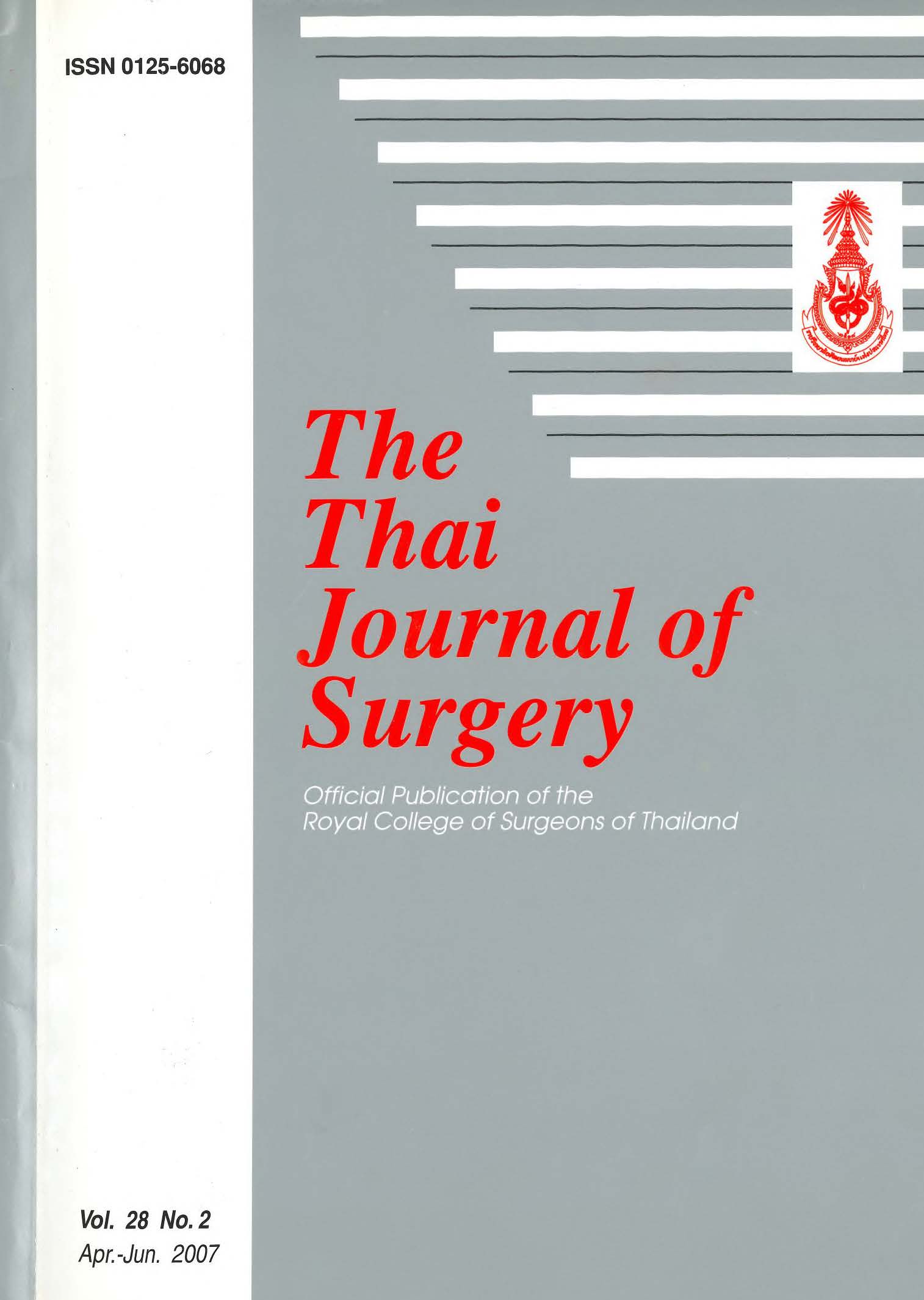Toxicity of Mitomycin C and 5-FU Regimen: Experience at Srinagarind Hospital, Khon Kaen University, Thailand
Keywords:
Mitomycin C, ToxicityAbstract
Objective: To evaluate the toxicities in patients receiving Mitomycin C (MMC) and 5-FU regimen.
Materials and Methods: Between October 2001 and September 2005, 199 medical records of patients treated with MMC and 5-FU regimen were reviewed. The regimen consisted of a bolus of MMC (10 mg/m2) on the first day and 5-FU (600 mg/m2/day) given as a continuous infusion for 5 days; these were repeated every 4 weeks for 6 cycles. Responses and toxicities were analyzed according to WHO criteria.
Results: The study population included a total of 199 patients; 122 males (61%) and 77 females (39%). Residents of Khon Kaen province comprised 21% of the study population, while those who lived outside the province constituted 79%. The age ranged from 15-70 years old (mean 52). Body surface area (BSA) averaged 1.51 m2. Only one-third of patients received a complete course of chemotherapy. There was no significant difference in the occurrence of toxicity between patients who received complete course of chemotherapy compared to those received incomplete course. Patients residing in Khon Kaen province were twice as likely to receive a complete course of chemotherapy as patients from outside (p = 0.04). Seventy-five percent of treated patients (150/199) developed toxicities during the courses of chemotherapy. Of these, gastrointestinal toxicities predominated (81%, 122/150) with nausea being the most common subtype, WHO severity grade II (56%, 68/122), followed by bone marrow suppression (43%, 65/150) with anemia being the most common subtype, WHO severity grade II (75%, 49/65).
Conclusions: The MMC and 5-FU regimen produced high toxicities. Most patients could not complete the regimen. Furthermore, economic constraints and difficulties in getting access to treatment facilities in this impoverished region also reduced compliance.
References
2. Chen JS, Lin YC, Jan YY, Liau CT, Mitomycin C with weekly 24-h infusion of high-dose 5-fluorouracil and leucovorin in patients with biliary tract and periampullar carcinomas. Anticancer Drugs 2001; 12: 339-43.
3. Takada T, Amano H, Yasuda H, et al. Is postoperative adjuvant chemotherapy useful for gallbladder carcinoma? A phase III multicenter prospective randomized controlled trial in patients with resected pancreaticobiliary carcinoma. Cancer 2002 Oct 15;95: 1685-95.
4. Liu LX, Zhang WH, Jiang HC, et al. Arterial chemotherapy of 5-fluorouracil and mitomycin C in the treatment of liver metastases of colorectal cancer. World J Gastroenterol 2002; 8:663-7.
5. Bosset JF, Roelofsen F, Morgan DA, et al. Shortened irradiation scheme, continuous infusion of 5-fluorouracil and fractionation of mitomycin C in locally advanced anal carcinomas. Results of a phase II study of the European Organization for Research and Treatment of Cancer. Radiotherapy and Gastrointestinal Cooperative Groups. Eur J Cancer 2003; 39: 45-51.
6. Rudi J, Werle S, Bergtholdt D, Hofheinz RD. Infusional 5-fluorouracil and mitomycin C: an effective regimen in the treatment of advanced gastric cancer. Onkologie 2005; 28:128-32.
7. Miller AB, Hoogstraten B, Staquet M, Winkler A, Reporting results of cancer treatment. Cancer 1981;47: 207-14.
8. Chester JD, Dent JT, Wilson G, Ride E, Seymour MT. Protracted infusional 5- fluorouracil (5-FU) with bolus mitomycin in 5-FU-resistant colorectal cancer. Ann Oncol 2000: 11: 235-7.
9. Sawada T, Hojo K, Moriya Y, Results of intra-arterial infusion chemotherapy in colorectal cancer patients with metastatic liver cancer. Gan To Kagaku Ryoho 1988; 15(8 Pt 2): 2437-42.
Downloads
Published
How to Cite
Issue
Section
License
Articles must be contributed solely to The Thai Journal of Surgery and when published become the property of the Royal College of Surgeons of Thailand. The Royal College of Surgeons of Thailand reserves copyright on all published materials and such materials may not be reproduced in any form without the written permission.



